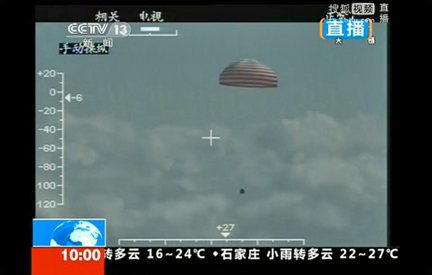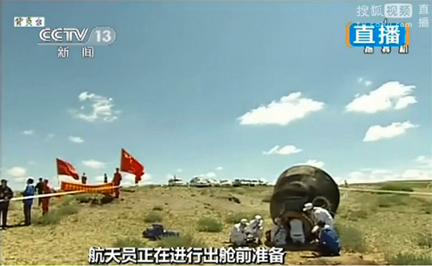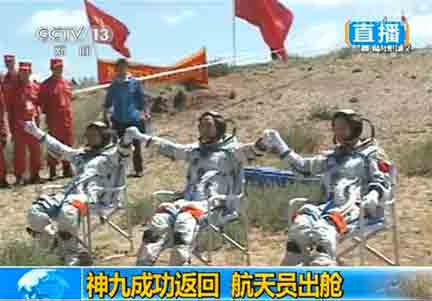Shenzhou 9 lands to close out successful test flight
06/29/2012 12:01 AM Filed in: Space News | China
By WILLIAM HARWOOD
CBS News
China's Shenzhou 9 spacecraft, carrying two men and the first Chinese woman to fly in space, returned to Earth Friday after an ambitious flight to a prototype space station module, plunging back into the atmosphere and descending under a large parachute to a jarring touchdown in Inner Mongolia.
The re-entry was carried live on Chinese television, with commentary, shots of the crew in the cramped desent module and views of the spacecraft's fiery re-entry plume as it streaked across the sky on a steep northeasterly descent toward the landing zone.
The 12-day 15-hour mission ended with a jarring rocket-assisted landing in Siziwang Banner, Inner Mongolia autonomous region, around 10:04 a.m. local time (GMT+8; 10:04 p.m. EDT Thursday). The spacecraft appeared to slide along on its base for an instant before rolling end over end, coming to rest on its side.
Within minutes, recovery crews stationed nearby reached the landing site, opened the vehicle's hatch and carried out initial medical checks. The crew was said to be in good health and all three smiled and waved to well wishers when they left the vehicle more than an hour after touchdown.
"I feel very happy and very proud of my country," Liu Yang, China's first female "taikonaut," told an interviewer.
All three crew members were to be flown by helicopter to Beijing for more extensive medical exams, debriefing and reunions with friends and family.
Launched June 16 from the Jiuquan Satellite Launch Center in north central China, commander Jing Haipeng, the first Chinese astronaut to make a second spaceflight, monitored an automated docking with the Tiangong 1 space station module on June 18. Jing, Liu Yang and crewmate Liu Wang then floated into the space station module for more than a week of tests and experiments.
A highlight of the flight was the crew's temporary departure from Tiangong 1 last weekend to test manual docking procedures that might be needed during future flights if the automatic system malfunctioned. Liu Wang successfully completed a manually controlled return to the station module to accomplish one of the major goals of the flight.
The solar-powered Tiangong 1 is roughly 34 feet long, 11 feet wide and weighs about 8.5 tons. The spacecraft includes an experiment module where visiting crews can live and work and a service module that houses electrical power, propulsion and life support systems.
Tiangong 1 is a prototype of the much larger laboratory components China hopes to launch and assemble in orbit later in the decade to build a Mir-class space station by the end of the decade. While Chinese officials have mentioned the possibility of eventual flights to the moon, the space station project is the near-term focus of China's manned space program.
To perfect the techniques and procedures needed to build a space station, an unmanned Shenzhou spacecraft carried out an automated docking with Tiangong 1 shortly after lab module was launched late last year. The Shenzhou 9 flight was China's first manned docking mission and at least one more piloted flight to Tiangong 1 is expected next year.
The Chinese news agency Xinhua said Tiangong 1 would be maneuvered to a higher orbit after Shenzhou 9's departure to "wait for another spacecraft." The news agency said the module was designed to operate for two years and accommodate six docking "procedures."
"Based on current conditions, the service of Tiangong 1 can be extended," He Yu, chief manner of the Shenzhou 9 spacecraft, was quoted by Xinhua. "It has consumed less than one-fourth of its fuel and no back-up systems have been used."
He even raised the possibility that Tiangong 1 might still be serviceable after Tiangong 2 is eventually launched.
"If Tiangong 1 was in perfect shape, it could work side by side with Tiangong 2," he said.
CBS News
China's Shenzhou 9 spacecraft, carrying two men and the first Chinese woman to fly in space, returned to Earth Friday after an ambitious flight to a prototype space station module, plunging back into the atmosphere and descending under a large parachute to a jarring touchdown in Inner Mongolia.
The re-entry was carried live on Chinese television, with commentary, shots of the crew in the cramped desent module and views of the spacecraft's fiery re-entry plume as it streaked across the sky on a steep northeasterly descent toward the landing zone.
 |
| The Shenzhou 9 spacecraft descends under a large parachute toward landing in Inner Mongolia. (Credit: CCTV) |
Within minutes, recovery crews stationed nearby reached the landing site, opened the vehicle's hatch and carried out initial medical checks. The crew was said to be in good health and all three smiled and waved to well wishers when they left the vehicle more than an hour after touchdown.
 |
| Recovery crews work to help the Shenzhou 9 crew members out of their cramped spacecraft. (Credit: CCTV) |
All three crew members were to be flown by helicopter to Beijing for more extensive medical exams, debriefing and reunions with friends and family.
Launched June 16 from the Jiuquan Satellite Launch Center in north central China, commander Jing Haipeng, the first Chinese astronaut to make a second spaceflight, monitored an automated docking with the Tiangong 1 space station module on June 18. Jing, Liu Yang and crewmate Liu Wang then floated into the space station module for more than a week of tests and experiments.
 |
| The crew of Shenzhou 9 -- Liu Wang, Jing Haipeng and Liu Yang -- salute recovery crews after leaving their spacecraft. (Credit: CCTV) |
The solar-powered Tiangong 1 is roughly 34 feet long, 11 feet wide and weighs about 8.5 tons. The spacecraft includes an experiment module where visiting crews can live and work and a service module that houses electrical power, propulsion and life support systems.
Tiangong 1 is a prototype of the much larger laboratory components China hopes to launch and assemble in orbit later in the decade to build a Mir-class space station by the end of the decade. While Chinese officials have mentioned the possibility of eventual flights to the moon, the space station project is the near-term focus of China's manned space program.
To perfect the techniques and procedures needed to build a space station, an unmanned Shenzhou spacecraft carried out an automated docking with Tiangong 1 shortly after lab module was launched late last year. The Shenzhou 9 flight was China's first manned docking mission and at least one more piloted flight to Tiangong 1 is expected next year.
The Chinese news agency Xinhua said Tiangong 1 would be maneuvered to a higher orbit after Shenzhou 9's departure to "wait for another spacecraft." The news agency said the module was designed to operate for two years and accommodate six docking "procedures."
"Based on current conditions, the service of Tiangong 1 can be extended," He Yu, chief manner of the Shenzhou 9 spacecraft, was quoted by Xinhua. "It has consumed less than one-fourth of its fuel and no back-up systems have been used."
He even raised the possibility that Tiangong 1 might still be serviceable after Tiangong 2 is eventually launched.
"If Tiangong 1 was in perfect shape, it could work side by side with Tiangong 2," he said.